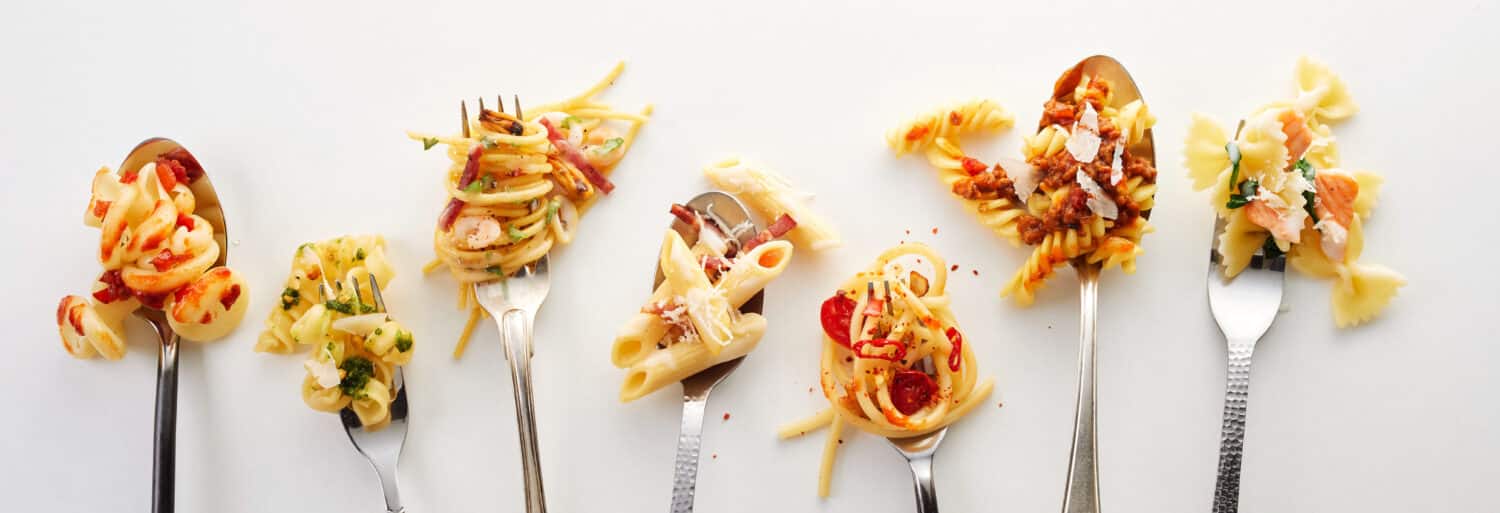Noodle vs. pasta, do you know the difference? Many people often interchange the terms noodles and pasta when preparing their meals. These two can have the same shape, texture, and color, but they are actually very different.
Pasta, linked to Italian cuisine, derives its flavor from a dough made with ingredients such as egg, flour, water, and semolina. You can form it in different shapes and sizes, depending on what type of dish you plan on creating.
Noodles are long, ribbon-like dough made of eggs and cooked flour, popular mainly in Asia. You can distinguish pasta from noodles by its shape.
If you want to know more about noodles and pasta, keep reading!
Noodle vs. Pasta: What is the Difference?
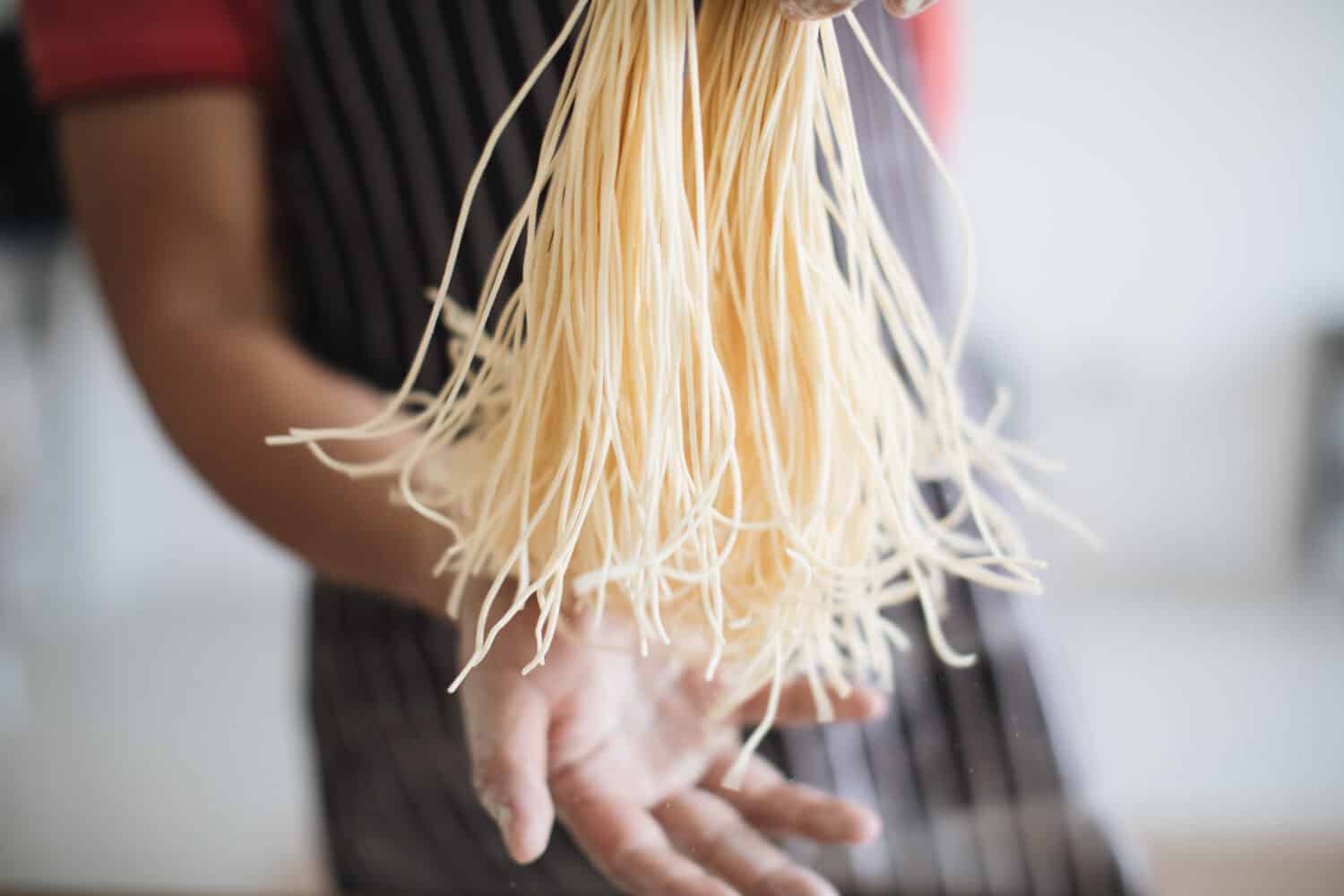
©Piyato/Shutterstock.com
Despite being widely popular and considered a common staple in many countries, people still find themselves confused by the differences between noodles and pasta. People still frequently interchange the terms “pasta” and “noodles” despite the fact that each has distinctive roots, histories, and uses. When differentiating a noodle vs. pasta, be sure to keep in mind these key differences:
1. Origin
A dough resembling pasta called ”lagana” first became known in the fourth century BCE in Italy. The lagana noodles are cooked differently. Instead of being boiled, compared to ordinary pasta nowadays, these are usually baked. Italy witnessed the emergence of pasta long before Marco Polo embarked on his voyage in search of new territories. However, the precise origins of pasta have sadly gotten lost with the passage of time.
Noodles were first identified in writing in Chinese literature that dates back around 3200 years. It's likely that pasta originated in China and the Middle East a few centuries earlier, as stated by Jen Lin-Liu.
2. Type of flour
The rough flour you use to make the pasta dough is a defining characteristic of pasta. In making pasta, you should use semolina flour, which is a type of flour made from durum wheat. In contrast, noodles are not restricted to any specific type of flour. Depending on the region and preference, the flour used in noodles can be made from different food sources, such as potatoes, rice, mung beans, and many more.
3. Egg content
Another distinct difference between noodles and pasta is the egg concentration. An item must meet particular prerequisites in order to be appropriately labeled as pasta or noodles. As per the National Pasta Association, noodles must have an egg substance of at least 5.5 percent. Contrarily, there's no set number of eggs that must be in pasta; as long as it is made from durum wheat, at that point, it is regularly labeled as pasta.
4. Process
The method of extrusion is utilized to form pasta. This infers that when the semolina flour and water are combined to create a mixture, the mixture is pushed or expelled through molds made of clay or coloring.
To create the dough of noodles, you begin with a flour base and then incorporate the eggs into it. After flattening, you slice the dough into long, thin strips. Since the sort of flour you use can get made from a wide variety of ingredients, noodles come in a wide range of assortments. The sort of flour utilized can frequently be determined by the area where the noodles are being made.
5. Recipes
Noodles are ordinarily made in hot or cold broths with an assortment of vegetables and meats to balance the richness of the ingredients like udon, pho, and ramen. On the other hand, pasta is regularly served with many types of sauces, whether homemade or store-bought. People commonly make pasta dishes with tomato- and cream-based sauces such as marinara, carbonara, and alfredo.
What is Pasta?
Italian pasta is a generic term for a group of foods made from wheat flour, water, and sometimes eggs. The name corresponds to the finished dough, which is at that point stretched out and formed into diverse shapes and sizes.
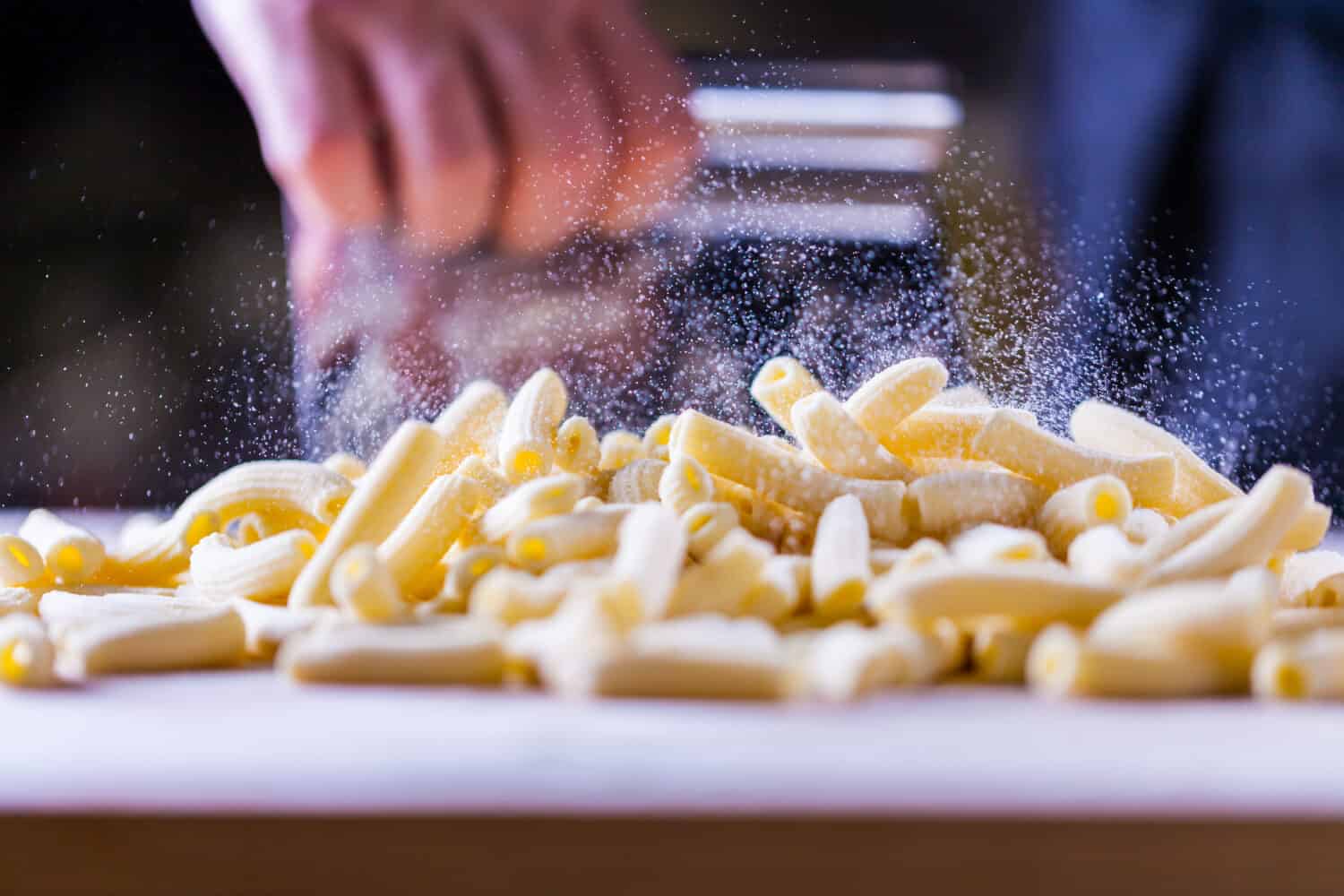
©Stereo Lights/Shutterstock.com
What is a Noodle?
The earliest written historical books about noodles date back to a third-century A.D. lexicon in ancient China. The very first Chinese noodles were made from bread dough, which was then formed into small pieces before being dropped into a pot of boiling water to cook. Although some Asian pan-fried and stir-fried foods enable them to use wheat-flour noodles as a substitute for Chinese mein, Asian noodles are oftentimes made from substances other than flour.
Noodle vs. Pasta: Nutritional Value
Noodles and pasta have different nutritional values. Noodles, made from rice or wheat, are low in fat and gluten-free if made from rice. They provide carbohydrates that give you energy, and wheat-based noodles have more fiber and B vitamins that help with digestion and overall health.
Pasta, usually made from durum wheat semolina, also has nutritional benefits. Whole wheat pasta has lots of fiber that keeps your digestion on track and makes you feel full. It also has complex carbs that help keep your blood sugar levels steady. Pasta gives you important minerals like iron and magnesium that help your body use energy and keep your muscles working well.
The choice between noodles and pasta depends on what you need and like. If you want more fiber and minerals, whole wheat pasta is a good choice. But if you can't eat gluten or prefer something lighter, rice noodles are a good option. It's best to include a mix of whole grains and vegetables in your noodle or pasta dishes to make them even more nutritious and part of a balanced diet.
Best Substitutes for Pasta
The possibilities of a pasta recipe are endless. People are starting to get creative nowadays and are now using various food sources such as pasta. If you're someone who loves pasta but would like to consume less animal products, then here are a few alternatives that you may want to use:
Black bean pasta
The seemingly unappealing black bean noodles that are frequently featured in Korean dramas turn out to be full of protein, iron, calcium, and fiber, have a low glucose and calorie content, and are gluten-free. Despite black bean pasta's earthy, sour, and decadent flavor compared to the typical pasta nowadays, the consistency makes it quicker for the sauces to be soaked up by the pasta.
Spaghetti squash
It is by nature gluten-free, low in calories and fat, and rich in fiber compared to traditional pasta, given that it is made from squash.
While spaghetti squash might lack a dominating taste, its mild flavor serves as a great choice to be paired with various sauces, notably those with a tomato base, cream-based sauces, and even olive oil or butter.
Spiralized Vegetables
Spiralized vegetables have taken the food industry by a frenzy in the past few years, and for a good reason: they present a simple and visually appealing approach to boosting your intake of vegetables. These are seen all over the Instagram feeds of food vloggers, given their healthy and aesthetically pleasing presentation.
Spiralized vegetables are those that have been cut into long, pasta-like strips using a spiralizer and then seasoned based on your preference.
Best Substitutes for Noodles
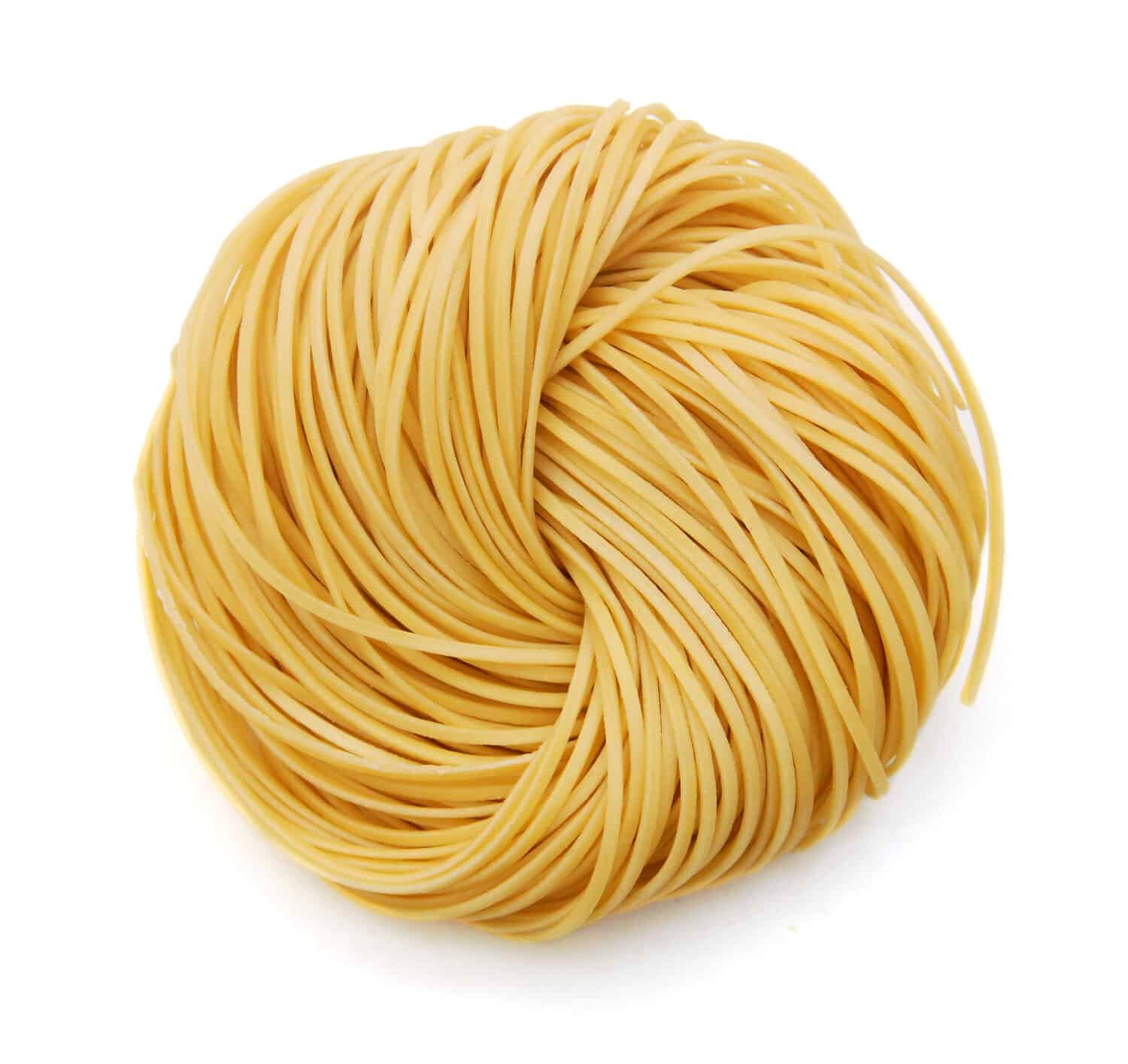
©Tiger Images/Shutterstock.com
Zucchini noodles
Zoodles, frequently referred to as zucchini noodles, are a good option for pasta. You may consume multiple servings of zoodles since each serving of medium zucchini only contains 33 calories and 6.9 grams of carbs (source: Calorie King). Since zucchinis consist mainly of water and thus have a low caloric content, removing the excess moisture is necessary for making firm pasta that mimics conventional pasta.
Mung bean noodles
These are made from mung beans, and sometimes they are produced with the use of mung bean flour. With their incredible nutritional value, mung beans frequently offer an array of health advantages. It has been shown that mung beans may boost your immune system, blood sugar, and overall cardiovascular wellness.
Shirataki noodles
Shirataki noodles, commonly referred to as konjac or miracle noodles, are long, white noodles. They are rich in fiber, which could offer tons of benefits to one's health, including assisting in managing weight as well as improving overall gut health. They do not contain any usual allergens that are found in other noodles and have only a few calories and carbohydrates.
Which is Healthier?
The protein levels in pasta are higher compared to regular noodles, which is a great alternative for bulking gym rats. Each half cup contains 4g of protein. However, a half-cup of noodles only has 0.8g of protein.
They both are great sources of carbohydrates and supply energy ultimately rather than abruptly. Typically, before a match, professional athletes eat both since their nutritional content is needed by their bodies to restore energy.
Can You Use Noodles As Pasta?
Of course you can! You can get creative with your dish and use noodles for your pasta. You can use spaghetti or fettuccini in your stir-fry in place of noodles if you want to try something new or come up with a new recipe. Although oftentimes some dishes call for a specific type of pasta or noodles since it is part of tradition or culture, just be sure to respect one's dish if you are cooking for someone else who has a different culture.
Which Tastes Better, Pasta or Noodles?
It all boils down to preferences. Some people are not used to the taste of pasta and prefer noodles, or vice versa, as this depends on what their culture and practices are or where they came from. Several factors may contribute to one's preference. In general, the choice between a noodle vs. pasta merely depends on the person's taste buds.
Noodle Recipes
- Ham Noodle Casserole Recipe
- Hungarian Beef and Noodles Recipe
- Salisbury Steaks with Buttered Egg Noodles Recipe
Pasta Recipes
Print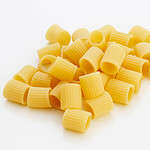
Wagon Wheel Beef Pasta
Ingredients
3/4 pound ground beef (85% lean)
1–3/4 cups (1 can) Vegetable Broth
1 Tablespoon Worcestershire sauce
1/2 teaspoon dried oregano leaves, crushed
1/2 teaspoon garlic powder
8 ounces stewed tomatoes
1-1/2 cups uncooked medium wagon wheel or corkscrew-shaped pasta
1 loaf Italian bread, sliced and warmed
Instructions
1. Cook ground beef in a 10-inch skillet over medium-high heat until well browned, stirring often to break apart the meat. Drain fat.
2. Stir the broth, Worcestershire sauce, oregano, garlic and tomatoes into the skillet and heat to a boil.
3. Stir in the pasta. Reduce the heat to low.
4. Cover and cook for 10 minutes, stirring often. Uncover.
5. Cook uncovered for 5 minutes longer or until the pasta is tender. Serve with buttered Italian bread slices.
- Italian Sausage and Pasta Bake Recipe
- Crab and Pasta Casserole Recipe
- Chicken Parmesan Pasta Toss Recipe
Final Thoughts
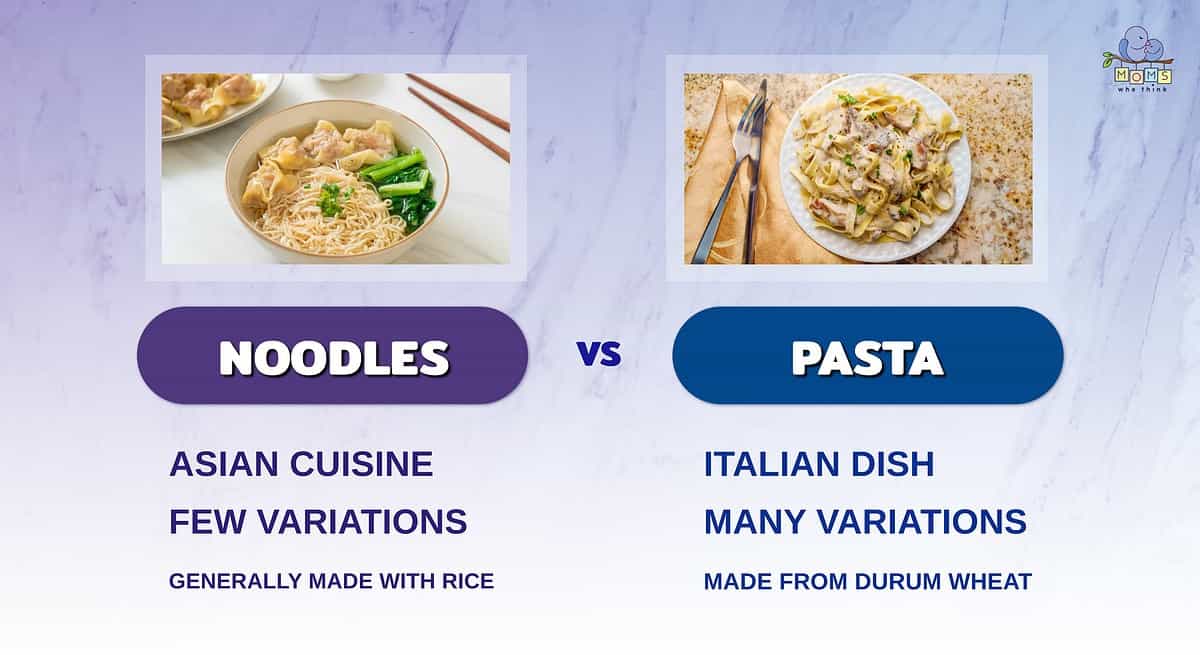
Noodles and pasta may seem like the same thing, but they are actually quite different. Let's take a look at how these two differ:
- Noodles originated as an Asian dish, while pasta is an Italian cuisine.
- There are quite a few variations in pasta. On the other hand, noodles have some variations, but not many.
- While some noodles are made from wheat, they are typically made from rice. Pasta is generally made from durum wheat semolina, although many options exist.
Most people tend to be confused with these two, as they are prepared similarly. However, there are variations in their production, nutritional content, consistency, forms, recipe, and origin.
Both noodles and pasta are rich sources of carbohydrate complexes. They do not mend your body instantly; rather, they gradually release energy. Some people stay away from these two since old beliefs claim that they can tremendously make you gain weight, but this is not true at all! These can still be consumed by people losing weight if they are consumed in moderation, which also applies to other foods.
Noodles and pasta undoubtedly have a long tradition together despite their distinct characteristics and qualities. Long into the years to come, their widespread popularity across different generations of preferences does not appear to be tapering off as the culinary world develops, and people are starting to make hybrid recipes that include ingredients from both, creating different flavor combinations and ingredients that a noodle vs. pasta are both unique and appetizing.
The image featured at the top of this post is ©Wirestock Creators/Shutterstock.com.
